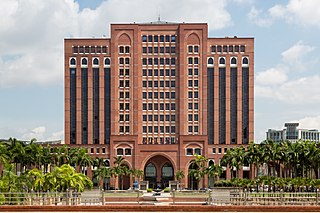
Civil defense or civil protection is an effort to protect the citizens of a state from human-made and natural disasters. It uses the principles of emergency operations: prevention, mitigation, preparation, response, or emergency evacuation and recovery. Programs of this sort were initially discussed at least as early as the 1920s and were implemented in some countries during the 1930s as the threat of war and aerial bombardment grew. Civil-defense structures became widespread after authorities recognised the threats posed by nuclear weapons.
The Civil Contingencies Secretariat (CCS), created in July 2001 and disbanded in July 2022, was the executive department of the British Cabinet Office responsible for emergency planning in the UK. The role of the secretariat was to ensure the United Kingdom's resilience against disruptive challenge, and to do this by working with others to anticipate, assess, prevent, prepare, respond and recover. Until its creation in 2001, emergency planning in Britain was the responsibility of the Home Office. The CCS also supports the Civil Contingencies Committee, also known as COBR.

Emergency management or disaster management is a science and a system charged with creating the framework within which communities reduce vulnerability to hazards and cope with disasters. Emergency management, despite its name, does not actually focus on the management of emergencies, which can be understood as minor events with limited impacts and are managed through the day-to-day functions of a community. Instead, emergency management focuses on the management of disasters, which are events that produce more impacts than a community can handle on its own. The management of disasters tends to require some combination of activity from individuals and households, organizations, local, and/or higher levels of government. Although many different terminologies exist globally, the activities of emergency management can be generally categorized into preparedness, response, mitigation, and recovery, although other terms such as disaster risk reduction and prevention are also common. The outcome of emergency management is to prevent disasters and where this is not possible, to reduce their harmful impacts.

The Ministry of Civil Defence, Emergencies and Disaster Relief is a Russian government agency overseeing the civil emergency services in Russia.
Emergency Management Australia (EMA) was an Australian Government body responsible for emergency management coordination. EMA was transferred from the Attorney-General's Department in a machinery of government change to become a division of the newly established Department of Home Affairs in 2018. EMA involved the plans, structures and arrangements which are established to bring together the normal endeavours of government, voluntary and private agencies in a comprehensive and coordinated way to deal with the whole spectrum of emergency needs including prevention, preparedness, response and recovery. It was dissolved on the 1 September 2022.
From 1935 to 1971 civil defence in the United Kingdom was the responsibility of the Civil Defence Department and resulted in the establishment during 1957 of the United Kingdom Warning and Monitoring Organisation. On the run-down of civil defence in 1971 the department was replaced by the Home Defence and Emergency Services Division of the Home Office.
From 1935 to 1971 civil defence in the United Kingdom was the responsibility of the Civil Defence Department. On the run-down of civil defence in 1971 the department was replaced by the Home Defence and Emergency Services Division of the Home Office. It was renamed the Emergency Planning Division in the late 1980s. The head was an Assistant Secretary.

The Danish Emergency Management Agency (DEMA) is a Danish governmental agency under the Ministry of Defence. Its principal task is to manage an operational part who work out of six Emergency Management Centres, and administrative and legalizing part, who supervises the national and municipal rescue preparedness and advises the authorities on matters of preparedness. DEMA works in closely structured co-operation with the EU, UN and several neighbouring countries.

The Bangladesh Fire Service & Civil Defence (FSCD) is an emergency service that operates under the Security Services Division of the Ministry of Home Affairs in the People's Republic of Bangladesh. The department's primary objective is to provide critical public safety services, including fire protection, emergency medical care, and other essential services.

The Ministry of Home Security was a British government department established in 1939 to direct national civil defence, primarily tasked with organising air raid precautions, during the Second World War. The Ministry for Home Security was headed by Sir John Anderson, the Home Secretary and Minister of Home Security. The Ministry's responsibilities covered all central and regional civil defence organisations, such as air raid wardens, rescue squads, fire services, and the Women’s Voluntary Service. It was also responsible for giving approval to local ARP schemes and providing public shelters.

The Civil Defence Corps (CDC) was a civilian volunteer organisation established in Great Britain in 1949 to mobilise and take local control of the affected area in the aftermath of a major national emergency, principally envisaged as being a Cold War nuclear attack. By March 1956, the Civil Defence Corps had 330,000 personnel. It was stood down in Great Britain in 1968, although two Civil Defence Corps still operate within the British Isles, namely the Isle of Man Civil Defence Corps and the unrelated Civil Defence Ireland in the Republic of Ireland. Many other countries maintain a national Civil Defence Corps, usually having a wide brief for assisting in large scale civil emergencies such as flood, earthquake, invasion, or civil disorder.
The National Emergency Management Agency is the public service department of New Zealand responsible for providing leadership and support around national, local and regional emergencies. It is an autonomous departmental agency hosted by the Department of Prime Minister and Cabinet. It replaced the Ministry of Civil Defence and Emergency Management in December 2019.

The Ministry of Home Affairs, abbreviated KDN, MOHA, is a ministry of the Government of Malaysia that is responsible for home affairs: law enforcement, public security, public order, population registry, immigration, foreign workers, management of societies, anti-drug, publication / printing / distribution of printed materials, film control, management of volunteer, rehabilitation and implementation of punishment.

The Ministry of Emergency Situations of Azerbaijan Republic is the central executive body within the cabinet of Azerbaijan Republic responsible for protecting the population from natural and manmade disasters. The ministry is headed by Kamaladdin Heydarov.
Many countries around the world have civil defense organizations dedicated to protecting civilians from military attacks and providing rescue services after widespread disasters. In most countries, civil defense is a government-managed and often volunteer-staffed organization.

The Ministry of Defence (MoD) (Bengali: প্রতিরক্ষা মন্ত্রণালয়) is a Bangladeshi government ministry. The MoD is headed by the Minister of Defence, a civilian and member of cabinet. The post is usually held by the Prime Minister of Bangladesh, who also serves as the President's second-in-command of the military. The MoD exercises supreme command authority over the Bangladesh Armed Forces.

The Isle of Man Civil Defence Corps is one of the five emergency services maintained by the Isle of Man Government, to provide a range of emergency responses on the Isle of Man, an independent Crown dependency located in the Irish Sea between England and Ireland. The Corps operates under the Department of Home Affairs.

The Queensland State Emergency Service (QSES) in Queensland, Australia is a volunteer based organisation of the Queensland Government and forms part of the Queensland Fire and Emergency Services (QFES), responsible for disaster management and as an emergency services auxiliary.

The Malaysia Civil Defence Force is the civil defence services agency in Malaysia. Until 31 August 2016 it was known as the Civil Defence Department.

The Department of the Director of Dockyards, also known as the Dockyard Branch and later as the Dockyards and Fleet Maintenance Department, was the British Admiralty department responsible from 1872 to 1964 for civil administration of dockyards, the building of ships, the maintenance and repair of ships at dockyards and factories, and the supervision of all civil dockyard personnel.













